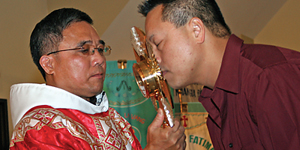
Lễ mừng các Thánh Tử Đạo Việt Nam

COLUMBIA—Catholics paid tribute to those who died for their faith at the Vietnamese Martyrs Celebration held Nov. 14 at St. Martin de Porres Church in Columbia.
Franciscan Father Khoa Nguyen, a priest for Vietnamese ministry in the Diocese of Charleston, celebrated Mass in his native tongue for a crowd of more than 370.
The statewide festival was sponsored by the Office of Ethnic Ministries. Recent census figures indicate about 4,000 Vietnamese people live in South Carolina, and the diocese serves an estimated 1,500.
This was the first martyrs’ celebration held in Columbia and St. Martin de Porres was selected because of its diverse membership.
The celebration honors 117 Vietnamese martyrs who were canonized by Pope John Paul II on June 19, 1988.
In Vietnam, Catholic missionaries were killed for their faith starting in the 16th century, but the largest time of persecution was the 1800s when ruling dynasties sought to eradicate the church, according to Catholic online.
They are sometimes called the Martyrs of Tonkin or Annam, or Andrew Dung-Lac and Companions. The exact number of those who died is unknown, but Vatican officials have estimated between 130,000 and 300,000.
The martyrs’ feast day is Nov. 24, but the celebration was held early this year because the closest Sundays were also the feast of Christ the King and the first Sunday of Advent, Father Nguyen said.
 Before the Mass, the crowd held a procession around the church grounds. Men held candles and a cross aloft, while a group of women in traditional dress carried a platform bearing a reliquary with relics from five of the martyrs.
Before the Mass, the crowd held a procession around the church grounds. Men held candles and a cross aloft, while a group of women in traditional dress carried a platform bearing a reliquary with relics from five of the martyrs.
At one point, the procession stopped and Father Nguyen knelt before the platform to cense and lead prayers.
During the Mass, a volunteer choir from Greenville and Rock Hill sang in Vietnamese, led by Sister Agnes Hanh Nguyen of the Daughters of Our Lady of the Holy Rosary.
Afterward, people stood in line to venerate the relics and then attended a reception with traditional foods and music.
Father Nguyen, who is based at St. Anthony of Padua Church in Greenville, said his homily focused on the important role that Vietnamese Catholics play in the life of the church around the world and in the diocese. He said it is important to reflect on their history and recognize the importance of sharing their faith with others.
“On this day, we thank God because He uses the Vietnamese people as a way to spread the good news,” the priest said. “It’s special that the Vietnamese have a role in spreading the Gospel.”
Father Nguyen said the celebration is one of two important feast days for the culture. The other is the feast of Our Lady of La Vang, which commemorates a vision of Mary that appeared in 1798 to Vietnamese Catholics who were being persecuted. She is honored annually at the Vietnamese Marian Celebration, usually held in May.
Michael Tran, a member of Our Lady of the Rosary Church in Greenville, said he was impressed with the large crowd and the number of people who drove long distances to honor the martyrs.
“This day really means a lot to us, and I know I’m very honored to be a descendant of our ancestors who kept the faith before us,” Tran said.
The life and death of St. Andrew Dung-Lac
By Amy Wise Taylor | The Catholic MiscellanyTo be a Catholic in Vietnam between 1798 and 1861 was to risk certain persecution, brutal torture, and death.
It was a time known as “the great massacre,” when hundreds of thousands of people were martyred.
One of these is St. Andrew Dung-Lac, who is a representative of the 117 men and women who were canonized by Pope John Paul II in 1988.
 St. Andrew Dung-Lac was born Dung An Trân and lived in a poor village in Hanoi, where he received a Christian education, according to a link on Wikipedia.
St. Andrew Dung-Lac was born Dung An Trân and lived in a poor village in Hanoi, where he received a Christian education, according to a link on Wikipedia.
He was ordained a priest in 1823 and became a vocal religious leader in his diocese and baptized many converts to Catholicism.
The priest was arrested for the first time in 1835, but members of his congregation raised donations to free him. In an attempt to avoid persecution, he changed his name to Lac [Andrew Lac] and moved to another prefecture, but continued to evangelize.
In 1839, he was visiting another Vietnamese priest to receive confession when he was arrested again, along with his religious brother, Peter Thi — who was also canonized.
Their followers purchased their freedom, but it was short-lived. When the two priests were arrested for the final time, they were taken to Hanoi and tortured. Both were beheaded in December 1839.
Andrew was among the first group of martyrs beatified in May 1900.
The tortures they endured, along with the other martyrs, are considered among the worst in Christian martyrdom. Those who were released were often branded on the face with the words ta dao, or false religion.
Churches, convents and schools were razed, and entire communities of Catholics were obliterated.
The martyrdoms ended with the Peace of 1862, when Saigon [Ho Chi Minh City] surrendered to France.
